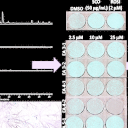
We present stilbenoid profiles of canes from 16 grapevines. Fifteen stilbenoids were obtained through isolation and structure identification using MS, NMR, and [α]D or as commercial standards. An HPLC–UV method for the simultaneous quantification of nine of these stilbenoids was developed and applied to canes of Vitis amurensis, Vitis arizonica, Vitis berlandieri, Vitis betulifolia, Vitis cinerea, Vitis × champini, Vitis × doaniana, Vitis labrusca, Vitis candicans (syn. Vitis mustangensis), Vitis riparia, Vitis rupestris, Vitis vinifera, Muscadinia rotundifolia, and a V. vinifera × M. rotundifolia hybrid. In these species, E-ampelopsin E, E-amurensin B, E-piceid, E-piceatannol, E-resveratrol, E-resveratroloside, E-ε-viniferin, E-ω-viniferin, and E-vitisin B were quantified, when found in sufficient amounts. Total concentrations ranged from ∼2.2 to 19.5 g/kg of dry weight. Additional stilbenoids, E-3,5,4′-trihydroxystilbene 2-C-glucoside, Z-ampelopsin E, Z-trans-miyabenol C, E-trans-miyabenol C, scirpusin A, and Z-vitisin B, were identified but not quantified. Our results indicate that canes, particularly those of non-vinifera species, have substantial quantities of valuable, health-promoting stilbenoids.





































